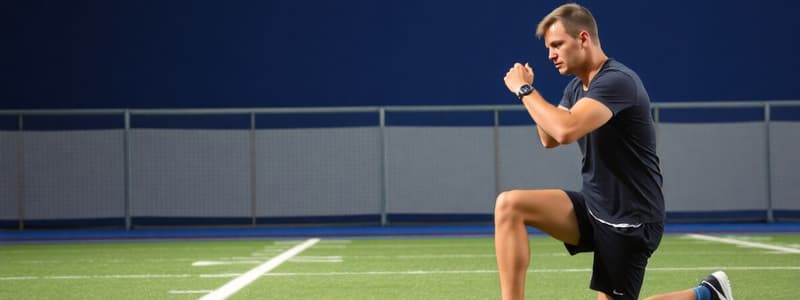Podcast
Questions and Answers
What is the primary goal of periodization?
What is the primary goal of periodization?
- To avoid physical fatigue
- To drive physical and metabolic adaptations (correct)
- To increase the frequency of training sessions
- To allow for active rest
Which training phase is characterized by high volume and less specialized work?
Which training phase is characterized by high volume and less specialized work?
- Specific Prep (SP)
- Transition (Active Rest)
- General Prep (GP) (correct)
- Competition (In-Season)
What is a benefit of periodization related to injury risk?
What is a benefit of periodization related to injury risk?
- It increases the total volume of training.
- It helps in drastically reducing performance decrements.
- It decreases the risk of injury. (correct)
- It eliminates the need for recovery periods.
During which phase is the volume typically lower and intensity higher?
During which phase is the volume typically lower and intensity higher?
What is the purpose of the Peaking phase in periodization?
What is the purpose of the Peaking phase in periodization?
What describes the Transition (Active Rest) phase?
What describes the Transition (Active Rest) phase?
What common issue does periodization help to prevent?
What common issue does periodization help to prevent?
In which phase does exercise selection become more specific to the sport's performance?
In which phase does exercise selection become more specific to the sport's performance?
What is the main purpose of periodization in training programs?
What is the main purpose of periodization in training programs?
Which of the following describes undulating periodization?
Which of the following describes undulating periodization?
What typically happens during the deload microcycle in a training program?
What typically happens during the deload microcycle in a training program?
In long-linear periodization, how does the training goal typically progress?
In long-linear periodization, how does the training goal typically progress?
What is the characteristic of linear periodization?
What is the characteristic of linear periodization?
What should be avoided to prevent accommodation and stagnation in training?
What should be avoided to prevent accommodation and stagnation in training?
During which phase of training is the intensity generally at its highest for long-linear periodization?
During which phase of training is the intensity generally at its highest for long-linear periodization?
Who benefits the most from the gradual progression in long-linear periodization?
Who benefits the most from the gradual progression in long-linear periodization?
Match the training phase with its primary characteristic:
Match the training phase with its primary characteristic:
Match the training phase with its corresponding purpose:
Match the training phase with its corresponding purpose:
Match the periodization benefit with its description:
Match the periodization benefit with its description:
Match the training phase with its usual duration:
Match the training phase with its usual duration:
Match the phase with its typical training focus:
Match the phase with its typical training focus:
Match the training phase with typical adjustments in volume and intensity:
Match the training phase with typical adjustments in volume and intensity:
Match the training phase to its strategic timing:
Match the training phase to its strategic timing:
Match the primary goal of each training phase:
Match the primary goal of each training phase:
Match the following types of periodization with their characteristics:
Match the following types of periodization with their characteristics:
Match the following terms with their correct definitions:
Match the following terms with their correct definitions:
Match the following phases of training with their primary focus:
Match the following phases of training with their primary focus:
Match the following adaptations with their training goals:
Match the following adaptations with their training goals:
Match the following programming concepts with their examples:
Match the following programming concepts with their examples:
Match the following training principles with their implications:
Match the following training principles with their implications:
Match the following training approaches with their intended benefits:
Match the following training approaches with their intended benefits:
Match the following concepts of periodization with their training strategies:
Match the following concepts of periodization with their training strategies:
Flashcards
Periodization in Training
Periodization in Training
A planned approach to training that changes over time to improve performance and avoid plateaus.
General Prep (GP)
General Prep (GP)
High-volume, less specialized training phase to build overall fitness; typical duration of 1-3 months.
Specific Prep (SP)
Specific Prep (SP)
High-volume phase with exercises more specific to the sport, to raise work capacity.
Competition Phase
Competition Phase
Lower volume, higher-intensity training focused on maintaining fitness and preventing injuries during competition.
Signup and view all the flashcards
Peaking Phase
Peaking Phase
Short phase at the end of a mesocycle; focused on maximizing performance by lowering volume and often increasing intensity.
Signup and view all the flashcards
Transition Phase
Transition Phase
Active rest phase to recover from competition/training; characterized by reduced traditional training, but with some activity.
Signup and view all the flashcards
Periodization Benefits
Periodization Benefits
Avoids plateaus, reduces injury risk, minimizes overtraining symptoms, and helps align team plans effectively.
Signup and view all the flashcards
Macrocycle
Macrocycle
The entire training plan, usually several months to a year long, including preparatory, competitive, and transition periods.
Signup and view all the flashcards
Periodization Variables
Periodization Variables
Factors influencing training programs, often manipulated to achieve specific adaptations, typically volume and intensity.
Signup and view all the flashcards
Linear Periodization
Linear Periodization
A training program that gradually transitions from endurance to strength, and then to power over a broader period of time.
Signup and view all the flashcards
Undulating Periodization
Undulating Periodization
A training program with multiple adaptations that shift between different training goals within the program (strength, endurance, etc.) rather than linearly progressive.
Signup and view all the flashcards
Progressive Overload
Progressive Overload
The principle of gradually increasing training demands over time to promote adaptation in athletes.
Signup and view all the flashcards
Deload
Deload
a planned reduction in training volume and intensity, aiming to restore energy and prevent overtraining.
Signup and view all the flashcards
Long-Linear Periodization
Long-Linear Periodization
A type of periodization in which training gradually increases from extensive workloads (high volume/low intensity) to intensive workloads (low volume/high intensity).
Signup and view all the flashcards
Why Periodize?
Why Periodize?
Periodization helps prevent performance plateaus, reduce injury risk, minimize overtraining symptoms, and align team plans.
Signup and view all the flashcards
What does Periodization involve?
What does Periodization involve?
Periodization uses planned phase changes and cycles in training to drive physical and metabolic adaptations for improved performance.
Signup and view all the flashcards
What's a Macrocycle?
What's a Macrocycle?
The entire training plan, spanning several months to a year, includes preparatory, competitive, and transition periods.
Signup and view all the flashcards
General Preparation (GP) Phase
General Preparation (GP) Phase
Focuses on high-volume, less specialized work, lasting 1 to 3 months, to build overall fitness.
Signup and view all the flashcards
Specific Preparation (SP) Phase
Specific Preparation (SP) Phase
Continues with high volume, but exercises become more sport-specific, raising work capacity for the athlete's specific activity.
Signup and view all the flashcards
Competition (In-Season) Phase
Competition (In-Season) Phase
Lower volume, higher-intensity training with sport-specific exercises to maintain fitness and prevent injuries during competition.
Signup and view all the flashcards
Transition (Active Rest) Phase
Transition (Active Rest) Phase
Recovery period after intense competition or training, characterized by reduced traditional training but still involving some activity.
Signup and view all the flashcards
Accommodation Stagnation
Accommodation Stagnation
When the body adapts to the same training stimulus, leading to a lack of improvement.
Signup and view all the flashcards
Deload Microcycle
Deload Microcycle
A planned period of reduced training volume and intensity to recover and prepare for the next training phase.
Signup and view all the flashcards
Supercompensation
Supercompensation
The body's ability to recover from training and become stronger than before the training period.
Signup and view all the flashcardsStudy Notes
Athletic Training & Conditioning - 3F03, Lecture 13
- Periodization is the planned application of phase changes and cycles in programming to improve performance and metabolic adaptations.
- It spans several months to a year.
- The plan includes preparatory, competitive, and transition periods.
Why Periodization?
- Prevents performance plateaus.
- Reduces performance decrements.
- Decreases risk of injury.
- Reduces signs and symptoms associated with overtraining.
- Allows coaches and staff to be on the same page.
- Balances monthly to annual team plans.
- The plan is adjusted as needed.
Overview of Training Phases
- An annual training plan structured into a macrocycle, with preparatory, competition, and transition periods.
- Training periods are broken down into preparatory periods, second transition periods, competition periods, and second transition periods.
- Specific training periods include off-season, pre-season, in-season, and post-season.
Periodization Cycle Hierarchy
- Quadrennial Cycle: A multi-year plan lasting more than four years.
- Macrocycle: The complete training period of less than one year.
- Mesocycle (Phase): A singular training cycle or block, lasting 3-4 weeks.
- Microcycle: The structural unit of a mesocycle, lasting one week.
- Workout: The structural unit of a microcycle.
Defining the Phases
- General Preparation (GP): High volume of less specialized work lasting 1-3 months.
- Specific Preparation (SP): Relatively high volume phase prioritizing sport-specific exercises to increase athletic work capacity.
- Competition (In-Season): Lower volume, higher intensity focused on specific exercises for maintaining athletic abilities and preventing injuries.
Defining the Phases cont'd
- Peaking: A climactic phase at the end of a mesocycle, aimed at maximizing performance. Characterized by lower volume and maintained or potentially increased intensity.
- Transition (Active Rest): A recovery phase after intense competition or training to prepare the athlete for future training. Characterized by no traditional training but some activity.
What are the Variables of Periodization?
- Phase Objectives: General preparation (strength-endurance), specific preparation (basic strength), competition (strength & power), peaking (maintenance).
- Variable: Intensity (High, moderate, low ), Volume (High, moderate, low).
- Repetitions: 8-20, and 4-6 (general preparation).
- Sets: 3-5, 3-5, 3-5 and 1-3 (General, special, competition, peaking).
- Sessions/Day: 1-3, 1-3, 1-2, 1 (sessions).
- Days/Week: 3-4, 3-5, 3-6, 1-5.
Review Adaptation Principle
- Adaptation is achieved through a series of phases: alarm, resistance, supercompensation, and potentially overtraining.
- This system is based on introducing stressors, adapting, and reaching a new baseline.
Progressive Overload in Action
- Avoid stagnation; without challenge adaptation does not occur; too much risk for a setback.
Types of Periodization
- Linear Periodization: Progression from endurance to strength to power, over a defined training time, towards a peak.
- Undulating Periodization: Adaptations in the program are not linear (different aspects emphasized in different phases). Multiple peaks, scheduling with other aspects, like practices, jobs and school.
Example of Linear Periodization
- 4-week mesocycle.
- 3 summated/loading microcycles with gradual increase in volume and/or intensity.
- 1 deload microcycle, useful for supercompensation and fatigue recovery, by reducing volume.
Adaptations of Periodization
- Long Linear: Intensity increases within mesocycles with a specific target range. Transition from extensive workloads (high volume, low intensity) to intensive workloads (low volume, high intensity).
- This is useful for young athletes.
Studying That Suits You
Use AI to generate personalized quizzes and flashcards to suit your learning preferences.




